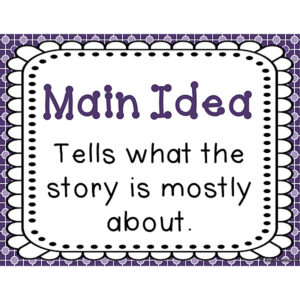
Examples of a Main Idea in a Story
Michael Stratford Updated March 09, 2017
The main idea of a story will closely relate to its theme and topic, but the main idea is neither just a topic nor a theme — both of those answer “what.” A story’s main idea includes actions — “how” — and motivations behind them — “why.” To find a story’s theme, ask yourself what universal statement is in the work and the “how” and “why” of the work.
Main Idea Versus Topic
“Clowns” is a topic; a main idea would be “clowns are enjoyable for some, scary for others.” Harold Bloom suggests that sometimes a main idea does not separate “how” from “why.” In Shakespeare’s “Julius Caesar,” the topic is Caesar’s assassination; the main idea is the how and why of Roman political corruption. We would arrive at that main idea because everything in the play revolves around it: Brutus’ indecision, the killing and its aftermath and the killers’ loss of freedom and life, all the results of a political system too entrenched to kill.
Main Idea in Content and Theme
Fiction presents main ideas about human nature and common life events. Sometimes, the content is the main idea; other times, the theme and main idea are inseparable. Growing up and learning about life is both a part of the plot and main idea of Harper Lee’s “To Kill a Mockingbird,” J.D. Salinger’s “Catcher in the Rye” and J.K. Rowling’s “Harry Potter” novels. The theme of man’s personality mirrored in his own enemies is a main idea in Herman Melville’s “Moby Dick,” Mark Twain’s “Huckleberry Finn” and Ian McEwan’s “Atonement.” Each novel has the same theme, but each main idea presents a different “how” and “why.”
Main Idea in Commentary
Another type of main idea is what the story says about its topic; the main idea is the commentary, as is found in social protest novels. Inequality between the sexes is a main idea explored in novels by Jane Austen, Alice Walker and Virginia Woolf, for example. The main idea of sociopolitical change and upheaval is analyzed in the works of such authors as Washington Irving, William Faulkner, Rudyard Kipling, Joseph Conrad and F. Scott Fitzgerald. In addition, all of these novels tell stories; the books do not exist only as commentary.
Main Idea in Repetition
Repetition is another method authors use to convey main ideas. John Steinbeck’s main idea in “Grapes of Wrath” is the desperation of Depression-era America; many scenes in the book show the Joad family in despairing situations. Tony Kushner’s main idea in “Angels in America” is the common humanity of the gay community. His work presents many instances of straight/gay intolerance. Whether as comment, plot-line or repeated scene, the main idea in any story is always what the story’s about, the “how” and “why.”
By Kelly Roell

 How Can I Locate the Main Idea?
How Can I Locate the Main Idea?